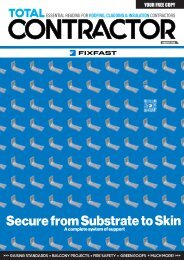March 2020
Create successful ePaper yourself
Turn your PDF publications into a flip-book with our unique Google optimized e-Paper software.
Steel Cladding
CONTRACTORS: STEPPING UP TO
THE INDUSTRIAL CHALLENGE
Being subject to high levels of industrial traffic, equipment and often located on busy urban
sites or exposed rural locations, industrial buildings come with an individual set of
requirements when it comes to their construction. In this article, Leighann Harris, Account
Manager at Hadley Group, explores the factors contractors need to consider when installing
external cladding on industrial buildings, so that they can ensure both high levels of client
satisfaction and a long-lasting, high-quality installation.
Ensuring that an industrial building’s
structure is able to deliver high levels of
strength and durability is imperative,
especially if it is to withstand the oftendemanding
environment for many years to come.
It is therefore perhaps no surprise that the
material of choice for industrial buildings
continues to be steel.
Indeed, while steel cladding is now increasingly
starting to find its way on to modern housing
developments, favoured for its clean and
contemporary design lines, it is still perhaps most
commonly recognised as
forming the face of the
UK’s industrial
buildings, renowned
for being both hardwearing
and resilient.
However, with so
many steel building
products and systems
available on the market, it
can be overwhelming for
contractors to identify the cladding
“Understanding the various processes can
enable you to discern a steel cladding product
which is of better quality, or which is able to
deliver higher levels of strength and durability”
best suited to a particular
application or project
requirements.
Corrugated or boxprofile
cladding is
perhaps the most
common choice for
industrial building roofs
and walls, particularly
when compared to flat sheet
cladding, with the corrugations
increasing the cladding’s overall tensile
strength and making the structure more resilient
to impact and weight loads, consequently
reducing the likelihood of dents or warping.
Differing manufacturing processes
It is also worthwhile for contractors to be aware
of the various steel manufacturing and
fabricating processes and the benefits of each.
While this may not appear immediately relevant,
understanding the various processes can enable
you to discern a steel cladding product which is
of better quality, or which is able to deliver higher
levels of strength and durability. For example, the
cold rollforming process involves steel being
passed through a series of contoured rolls,
progressively manipulating the metal until the
desired cross-section profile is achieved. Being
work hardened in a cold state allows for a highly
adaptable manufacturing process and the
potential for custom product design, as well as
56 TC MARCH 2020

















